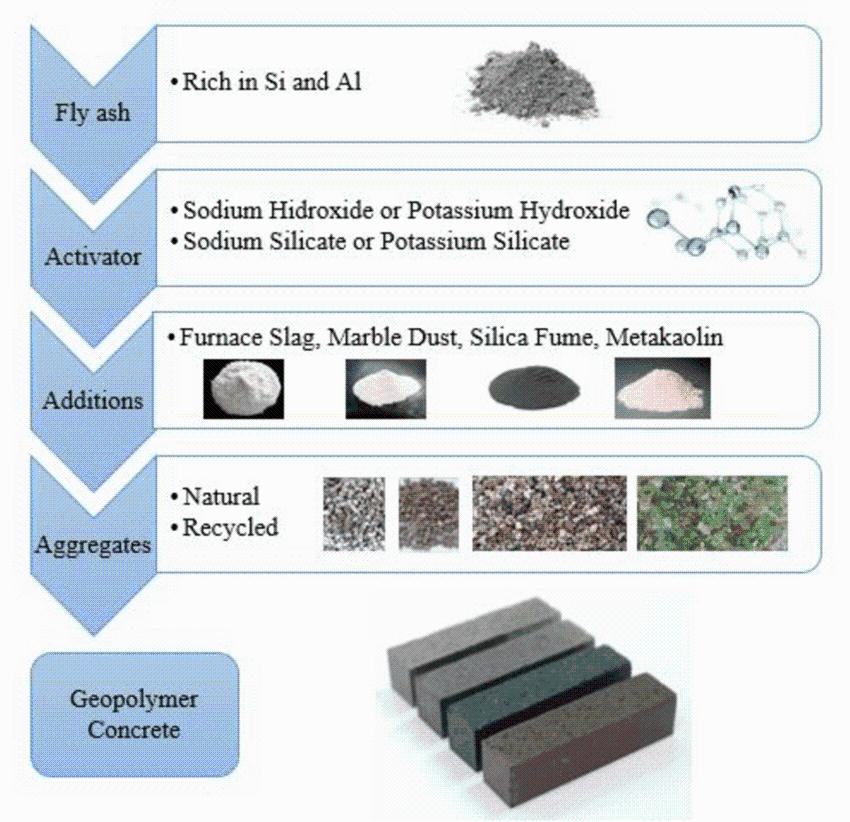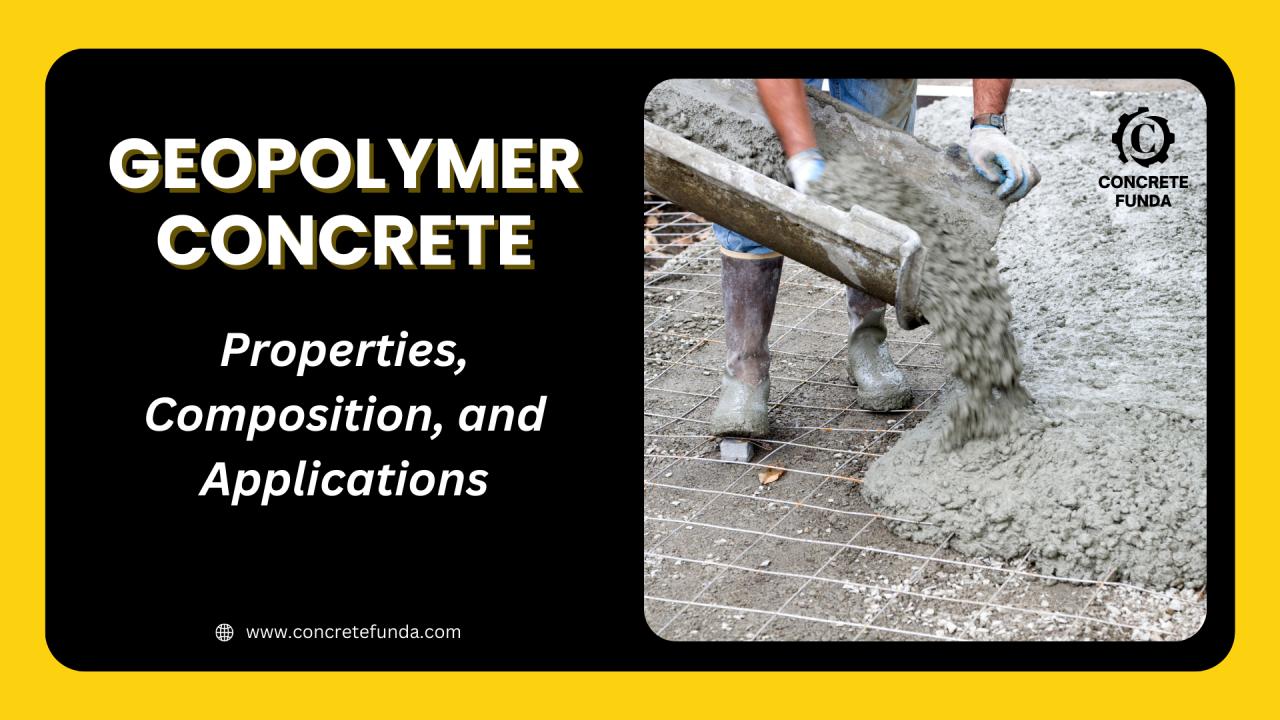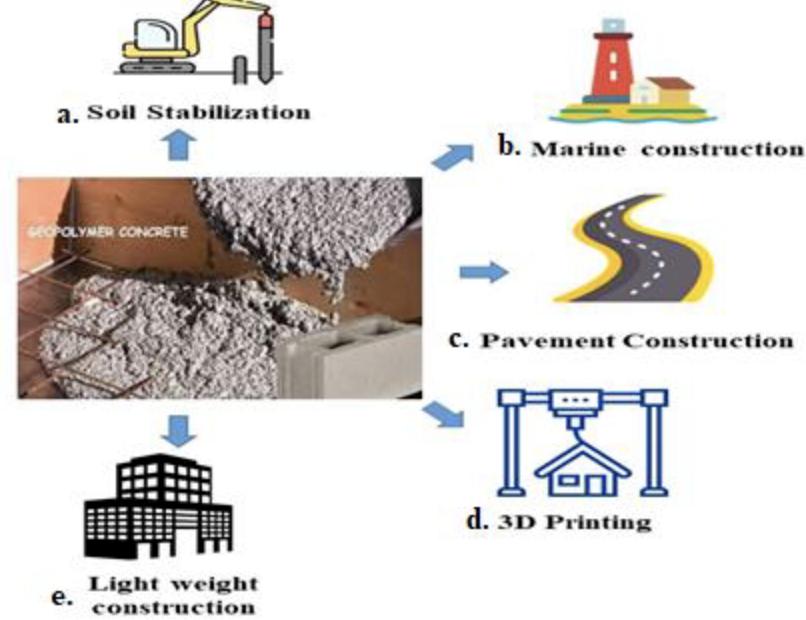



Table of Contents
- Introduction
- Understanding Geopolymer Concrete
- Composition of Geopolymer Concrete
- Properties of Geopolymer Concrete
- Advantages of Geopolymer Concrete
- Applications of Geopolymer Concrete
- Challenges and Considerations
- Recent Developments and Future Outlook
- Conclusion
- Faq's
Introduction
Geopolymer concrete has emerged as a groundbreaking alternative to traditional Portland cement concrete, offering a sustainable solution that addresses environmental concerns associated with conventional construction materials. By utilizing industrial by-products and reducing carbon emissions, geopolymer concrete not only enhances structural performance but also promotes eco-friendly construction practices.
Understanding Geopolymer Concrete
Geopolymer concrete represents a transformative advancement in sustainable construction materials, offering an eco-friendly alternative to conventional Portland cement-based concrete. Its core innovation lies in its chemical composition, which replaces cement with aluminosilicate-rich industrial by-products such as fly ash, ground granulated blast furnace slag (GGBS), and metakaolin. These materials, when activated with alkaline solutions like sodium hydroxide (NaOH) and sodium silicate (Na2 SiO3), undergo a geopolymerization reaction, forming a three-dimensional polymeric chain and network. This process results in a high-strength, durable, and heat-resistant concrete that performs exceptionally well in aggressive environments, such as marine structures, chemical plants, and high-temperature applications. Additionally, since geopolymer concrete does not require the high-temperature clinker production process associated with Portland cement, it significantly reduces CO2 emissions, making it a key player in the shift toward greener construction practices.
 Geopolymer Concrete, Topcem Cement
Geopolymer Concrete, Topcem Cement
Beyond its environmental benefits, geopolymer concrete also offers superior mechanical properties and durability compared to traditional concrete. It exhibits higher early strength, low shrinkage, and excellent resistance to sulfate attacks, chloride penetration, and acid exposure, making it ideal for infrastructure projects that demand long-term performance. Moreover, its fire-resistant properties allow it to withstand extreme temperatures, reducing the risk of structural failure in fire-prone areas. With the global construction industry seeking low-carbon and sustainable alternatives, the adoption of geopolymer concrete is gaining momentum. However, challenges such as standardization, raw material availability, and mix design optimization still need to be addressed for widespread implementation. As research progresses, geopolymer concrete holds immense potential to revolutionize the industry by offering a cost-effective, durable, and environmentally responsible building material.
Also Read: Abutments in Construction Projects: Types, Functions, Design Considerations and More
Composition of Geopolymer Concrete
 Compositional Geoplymer Concrete, Research Gate
Compositional Geoplymer Concrete, Research Gate
The primary constituents of geopolymer concrete include:
- Aluminosilicate Source: Materials rich in silicon (Si) and aluminum (Al), such as fly ash, GGBS, or metakaolin.
- Alkaline Activator: A combination of alkaline solutions, typically sodium hydroxide (NaOH) and sodium silicate (Na2 SiO3), which initiate the geopolymerization process.
- Aggregates: Coarse and fine aggregates similar to those used in traditional concrete.
- Water: Used to achieve the desired workability.
The chemical reaction between the aluminosilicate source and the alkaline activator forms a three-dimensional polymeric chain and ring structure, resulting in a hardened binder that exhibits superior mechanical and durability properties.
Properties of Geopolymer Concrete
Geopolymer concrete offers a range of properties that make it a compelling choice for various construction applications:
 Geopolymer Concrete Properties, LinkedIn
Geopolymer Concrete Properties, LinkedIn
High Compressive Strength
Geopolymer concrete exhibits high compressive strength, often matching or surpassing that of traditional Portland cement concrete. This makes it a strong and reliable material for load-bearing structures, bridges, high-rise buildings, and precast elements. The polymerization reaction that occurs between aluminosilicate materials and alkaline activators creates a dense microstructure, allowing it to withstand heavy loads and extreme stress conditions. Additionally, its higher resistance to fatigue and impact makes it ideal for pavements, highways, and infrastructure projects that demand long-term strength and durability.
Low Shrinkage
One of the significant advantages of geopolymer concrete is its low shrinkage properties, which help in minimizing the risk of cracks and deformation. Unlike traditional concrete, which undergoes significant drying shrinkage due to the hydration process, geopolymer concrete has a stable chemical structure that reduces volumetric changes over time. This property enhances the longevity and durability of structures, making it particularly beneficial for large-scale infrastructure, dams, tunnels, and marine applications where crack resistance is crucial.
Excellent Fire and Heat Resistance
Geopolymer concrete has superior fire and heat resistance compared to conventional concrete, making it ideal for fire-prone environments and high-temperature applications. Unlike Portland cement concrete, which tends to spall and lose structural integrity at high temperatures, geopolymer concrete can withstand temperatures exceeding 800-1000°C without significant degradation. This makes it highly suitable for fireproof buildings, industrial furnaces, chimneys, refractory structures, and nuclear power plants. Its non-flammable and heat-resistant nature provides an added layer of safety in case of fire hazards, reducing damage and improving structural resilience.
Superior Durability
Geopolymer concrete is known for its outstanding durability, particularly in aggressive environments where conventional concrete is susceptible to deterioration. It exhibits high resistance to acid attacks, sulfate exposure, chloride penetration, and freeze-thaw cycles, making it an excellent choice for marine structures, wastewater treatment plants, chemical factories, and coastal infrastructure. Additionally, its low permeability prevents water ingress, thereby protecting embedded steel reinforcement from corrosion, significantly extending the lifespan of structures. With its enhanced resistance to environmental and chemical stressors, geopolymer concrete reduces maintenance costs and increases the sustainability of construction projects.
Rapid Strength Gain
Another major advantage of geopolymer concrete is its fast strength development, allowing it to achieve high compressive strength within a short period. While traditional concrete requires 28 days for full strength development, geopolymer concrete can reach significant strength in just 24-48 hours, depending on the mix design and curing conditions. This accelerated strength gain makes it an excellent choice for precast elements, rapid construction projects, emergency repairs, and pavement applications where speed and efficiency are critical. By reducing construction time, it also helps in lowering labor costs and improving overall project timelines, making it an attractive option for modern infrastructure development.
Also Read: Curing Compounds in Construction: Why They Matter for Quality Concrete Work
Advantages of Geopolymer Concrete
 Geopolymer vs Cement, Linkspringer
Geopolymer vs Cement, Linkspringer
The adoption of geopolymer concrete presents several benefits:
Environmental Sustainability
Geopolymer concrete plays a vital role in promoting environmental sustainability by utilizing industrial waste materials such as fly ash, ground granulated blast furnace slag (GGBS), and metakaolin, which would otherwise contribute to landfill waste. By repurposing these by-products, geopolymer concrete reduces the demand for virgin raw materials, thereby conserving natural resources such as limestone and clay, which are heavily used in Portland cement production. Additionally, its lower water demand compared to traditional concrete minimizes freshwater consumption, making it an eco-friendly alternative for regions facing water scarcity.
Reduced Carbon Emissions
One of the most significant advantages of geopolymer concrete is its ability to dramatically lower carbon emissions associated with construction. Unlike Portland cement, which requires high-temperature kiln operations (around 1400-1500 degree C) for clinker production, geopolymer concrete does not undergo such an energy-intensive process. As a result, it reduces CO2 emissions by up to 80%, making it a crucial solution in combating climate change and meeting global sustainability goals. The reduced reliance on traditional cement also helps curb greenhouse gas emissions from cement factories, contributing to cleaner air and a healthier environment.
 Advantages of Geopolymer Concrete, Research Gate
Advantages of Geopolymer Concrete, Research Gate
Enhanced Durability
Geopolymer concrete exhibits superior durability compared to conventional cement-based concrete, making it highly resistant to chemical attacks, sulfate exposure, acid degradation, and chloride penetration. This makes it ideal for applications in marine structures, sewage treatment plants, and industrial facilities where harsh environmental conditions are common. Additionally, its low shrinkage and creep properties help prevent cracks and structural failures over time. With a longer service life and reduced deterioration, geopolymer concrete helps in minimizing repair and maintenance costs, ensuring sustainable and resilient infrastructure.
Economic Benefits
From a cost perspective, geopolymer concrete presents significant economic advantages by reducing reliance on expensive Portland cement and instead utilizing readily available industrial by-products. This can lead to lower material costs in regions with abundant sources of fly ash or GGBS. Additionally, its rapid strength gain allows for faster construction times, reducing labor and project costs. The long-term savings are even more pronounced, as geopolymer concrete requires less maintenance and has a longer lifespan, reducing the need for frequent repairs and replacements in infrastructure projects. As industries and governments push toward cost-effective and sustainable building solutions, geopolymer concrete is emerging as a viable alternative that balances economic feasibility and environmental responsibility.
Applications of Geopolymer Concrete
Geopolymer concrete is versatile and can be employed in various sectors:
 Application of Geopolymer Concrete, Research Gate
Application of Geopolymer Concrete, Research Gate
Infrastructure Projects
Geopolymer concrete is an excellent choice for large-scale infrastructure projects, including bridges, tunnels, highways, and railways, due to its high compressive strength, durability, and resistance to harsh environmental conditions. Unlike traditional concrete, which can deteriorate over time due to carbonation and sulfate attack, geopolymer concrete maintains its structural integrity even in aggressive environments. Additionally, its rapid strength gain allows for faster construction and reduced downtime in critical infrastructure developments. By incorporating geopolymer concrete into infrastructure projects, governments and engineers can ensure long-lasting, sustainable, and low-maintenance structures, ultimately reducing overall lifecycle costs.
Marine and Coastal Structures
Due to its excellent resistance to chloride penetration and sulfate attacks, geopolymer concrete is highly suitable for marine and coastal structures such as seawalls, piers, jetties, docks, and offshore platforms. Traditional concrete structures in coastal areas are prone to corrosion from saltwater exposure, leading to premature deterioration and costly repairs. However, geopolymer concrete exhibits low permeability, preventing water ingress and protecting embedded steel reinforcements from corrosion. This makes it an ideal solution for coastal infrastructure, ensuring greater durability, longevity, and reduced maintenance needs, even in aggressive marine environments.
Industrial Floors
Industrial facilities such as factories, warehouses, refineries, and chemical plants require flooring materials that can withstand heavy mechanical loads, thermal stress, and chemical exposure. Geopolymer concrete provides exceptional resistance to acids, alkalis, and other corrosive substances, making it a superior alternative to traditional concrete for chemical storage areas, food processing plants, and industrial warehouses. Its high abrasion resistance ensures that floors remain intact even under heavy machinery and constant wear and tear, reducing repair and replacement costs. Additionally, its fire-resistant properties make it an ideal choice for industries dealing with high-temperature processes and flammable materials.
Precast Concrete Products
Geopolymer concrete is widely used in the precast concrete industry for manufacturing beams, columns, panels, pipes, railway sleepers, and paving blocks. Its fast-setting and high early strength characteristics allow for quicker demolding and reduced curing time, leading to higher production efficiency in precast factories. Additionally, the dimensional stability and reduced shrinkage of geopolymer concrete ensure better quality control in precast elements, minimizing the risk of cracks and defects. By adopting geopolymer concrete in precast applications, construction companies can achieve cost savings, enhanced durability, and sustainable building solutions, making it a preferred choice for modern modular and prefabricated construction techniques.
Also Read: Retaining Walls: A Complete Guide to Design, Construction, and Costs
Challenges and Considerations
Despite its advantages, the widespread adoption of geopolymer concrete faces certain challenges:
- Material Availability: Dependence on specific industrial by-products may limit its application in regions where these materials are scarce.
- Standardization: Lack of universally accepted standards and codes for mix design and performance evaluation.
- Curing Conditions: Some geopolymer mixes require elevated temperature curing, which may not be feasible for all projects.
- Alkaline Activator Handling: The use of highly alkaline solutions necessitates careful handling and safety measures.
Recent Developments and Future Outlook
Research and development in geopolymer technology are progressing, focusing on:
Ambient Temperature Curing
One of the significant challenges of geopolymer concrete has been its reliance on elevated temperature curing to achieve optimal strength development. This requirement limits its widespread use, particularly in on-site construction projects where heat curing is impractical. Recent research is focused on developing geopolymer formulations that cure effectively at ambient temperatures, making the material more accessible and easier to use. Innovations in mix design and activator solutions are enabling geopolymer concrete to achieve comparable strength and durability at room temperature, paving the way for broader applications in general construction without the need for specialized curing techniques.
Alternative Activators
Traditional geopolymer concrete formulations use highly alkaline activators such as sodium hydroxide (NaOH) and sodium silicate (Na2 SiO3), which can be hazardous to handle and pose environmental concerns. Ongoing research aims to develop less corrosive and more sustainable activators that maintain the high-performance characteristics of geopolymer concrete while improving worker safety and reducing chemical waste. Some promising alternatives include organic-based activators, alternative alkaline salts, and hybrid activator systems, which offer enhanced efficiency, reduced costs, and lower environmental impact. By making activators safer and more eco-friendly, the adoption of geopolymer technology in mainstream construction can be accelerated.
Standardization Efforts
The lack of uniform codes and standards has been a barrier to the widespread adoption of geopolymer concrete. Unlike traditional concrete, which has well-established design principles and regulations, geopolymer concrete is still in the process of being recognized in international building codes. Governments and research institutions are working towards developing standardized testing methods, performance criteria, and design guidelines to provide a clear framework for engineers, architects, and builders. As these standards become widely accepted, it will facilitate easier integration of geopolymer concrete into construction projects, increasing industry confidence and encouraging broader adoption.
Field Applications
While laboratory research has demonstrated the exceptional strength and durability of geopolymer concrete, real-world field applications are crucial in proving its long-term reliability. Several infrastructure projects worldwide, including bridges, road pavements, and precast structures, have successfully utilized geopolymer concrete, showcasing its performance in diverse environments. By documenting case studies, performance evaluations, and lifecycle assessments, researchers are building valuable data that reinforces the material's viability and benefits. These practical applications are helping convince industry stakeholders, including governments, contractors, and developers, to invest in and adopt geopolymer concrete as a mainstream construction material.
Future Outlook
As the construction industry shifts towards sustainable and low-carbon materials, geopolymer concrete is expected to play a pivotal role in reducing environmental impact while delivering high-performance structures. With ongoing advancements in ambient curing, alternative activators, standardization, and field implementation, the material is becoming more accessible, cost-effective, and widely accepted. As global regulations tighten around carbon emissions and green building practices, geopolymer concrete is well-positioned to become a mainstream alternative to traditional cement. Continued investment in research, awareness, and infrastructure adoption will further accelerate its growth, making it a key contributor to the future of eco-friendly construction.
As the construction industry increasingly prioritizes sustainability, geopolymer concrete is poised to play a pivotal role in reducing environmental impact while delivering high-performance building materials.
Conclusion
Geopolymer concrete represents a significant advancement in construction materials, offering a sustainable and high-performance alternative to traditional Portland cement concrete. By capitalizing on industrial by-products and reducing carbon emissions, it addresses critical environmental challenges while meeting the demanding requirements of modern infrastructure. Continued research, standardization, and awareness are essential to overcoming existing challenges and promoting the widespread adoption of this promising material.
explore further
Latest from Sustainable
More from Innovations
Resources
Dwello, for every home buyer, is a way to go from 'I feel' to 'I know', at no extra cost.




